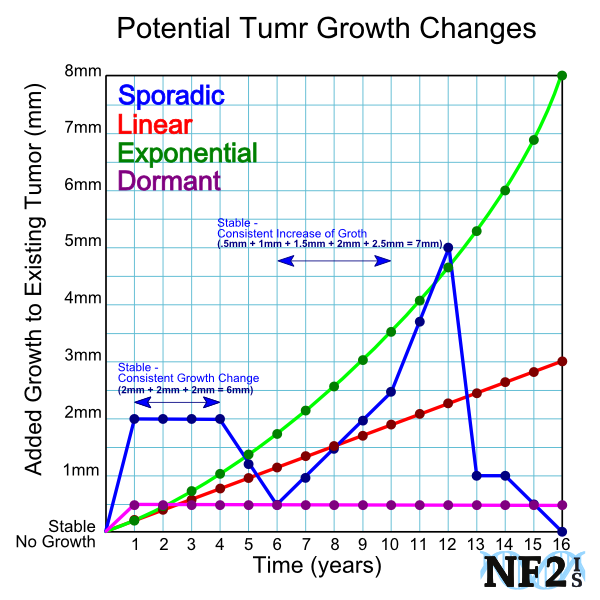Understanding NF2 > NF2 Tumors >
NF2 Tumor Growth
Last Updated: 04/20/21
Index
- Genetics
- Radiation
- Ionizing Radiation
- Non-ionizing Radiation
- Hormones
- Food and Diet (Carcinogens)
- Animal Growth Hormones (rBGH)
- BPA (Bisophenal A)
- Pesticide
- Additional Food Concerns
- Encvirnment Variables
- Surgery Stress
- Occupation Risks
- Environmental Risks
- Cell Phone Use
- Cigarettes (Tobacco)
- Tumor Growth Pattern
- Meningioma:
Pathophysiology of Meningioma Growth Risks - Vitamin B12:
Healing Nerve Damage
Also See
The facts contained here are primary facts proven about to benign meningioma (non-cancerous); these risks are also potential growth factors for all tumor types including schwannoma, and ependymoma.
Malignant (cancerous) tumors grow fast as they spread to other parts of the body, with lethal consequences when not treated fast enough and with the right treatments. Benign tumors growing at a slow rate can be just as harmful, especially within the brain where the smallest growths can be dangerous. It is for this reason that in 2002, The Benign Brain Tumor Cancer Registries Amendment Act (H.R. 5204), was passed mandating registration of benign brain tumors such as meningioma in the United States. As a result of this studies have been done to understand these tumors better. [Wiemels, 2010]
While there are different tumors individuals with NF2 may develop, meningioma was the primary focus of the primary citation for this page. A meningioma is an encapsulated tumor and when they grow to result in pressure to the surrounding brain area. These tumors grow as a result of different conditions, but the majority of these tumors frequently grow in individuals with NF2. Variables that result in increased tumor growth was at a higher rate when found in individuals with NF2 in comparison to when Meningioma was found and monitored for individuals without NF2, and these tumors grow faster in women over men. [Wiemels, 2010]
Tumor growth rates can vary dramatically. Different growth rates are the results of:
- Genetics
- Environmental and Life Factors
1. Genetics
The condition neurofibromatosis type 2 (NF2) results in a loss or damage of or a dysfunctional NF2 gene which results in a lack of the MERLIN protein, NF2 a tumor suppressor gene. Development and growth rate of tumors is primarily determined based on each NF2 mutation, even if other factors may increase the rate of growth; things that could risk increase tumor growth include environmental and lifestyle variables. Tumors will automatically grow at some rate by natural life progression starting at birth.
From first to the second generation, NF2, an individual might have more tumors and faster growth than parents; by the third generation, general growth pattern would be about the same. Symptoms dealt with would be different, if a person might have genetics to grow tumors in the spine as damage at each vertebra would result in different actual issues. But understanding of environmental variables could help a person ultimately have a slower rate of growth than other NF2 family.
The variables discussed here may affect not just people who have the NF2 condition, but other tumor growth issues that also develop because of a mutated tumor suppressor gene.
All of these things are topics that require more research.
2. Radiation
Proven increase in meningioma tumors following high-dose exposure to ionizing radiation, including; Atomic Bomb Survivors, Radiation Therapy, full-mouth Dental Radiographs, full-mouth Dental X-rays and Computed Tomography scans (CT Scans). [Wiemels, 2010] It is assumed likely other tumor types would also have risks of growth when exposed to ionizing radiation.
There are two (2) forms of radiation; Ionizing and Non-Ionizing, the Non-Ionizing are accepted safe forms.
Ionizing Radiation
- Natural Sources: Ultraviolet Radiation (Sun and Cosmic Energy), uranium, ores, and nuclear wastes
- Consumer Products: Tobacco Smoke
- Medical Scans: CAT Scan (CT Scan), Positron Emission Tomography (PET), and X-Rays (Mammograms, Medical and Dental X-Rays [Claus, 2012])
- Medical Treatments: CyberKnife, Gamma Knife, and Proton Beam Radiation Treatments
- Other: Atomic Bomb
It can cause damage to matter, particularly living tissue. At high levels, it is, therefore, dangerous, so it is necessary to control our exposure.[World Nuclear News]
Non-ionizing Radiation
Magnetic Field Exposure including; MRIs, Ultrasound, Light, Infrared, Radio Waves, Microwaves, Cell Phones and Cell Towers.
3. Hormones
Proven increase in Meningioma growth during the peak reproductive years (age 23 to 35), the presence of estrogen, progesterone, and androgen receptors, the certain phase of the menstrual cycle and pregnancy. As of 2010, there was not enough data for definitive results for oral contraceptives or hormone replacement therapy (HRT). [Wiemels, 2010] Meningioma growth during pregnancy has since been concluded to be a result of blood flow changes for infant development, not hormonal, Haemodynamic Response.[Wiemels, 2010]
Hormone Risk - Summary: Estrogen, Progesterone, both used in Birth Control Pills and Menopause hormone treatment and Androgen Receptors for increased Testosterone levels.
Other Risk Factor Pregnancy can cause tumor growth increases at different stages of pregnancy but is not a result of hormones. Tumor growth during pregnancy is a result of Hemodynamic Changes. Hemodynamic changes are changes during pregnancy of blood flow in different areas of the body to support the fetus.
4. Food and Diet (Carcinogens)
The term diet refers to combinations of foods eaten or specifically avoided, some examples would be; vegetarian, vegan, ketogenic, and the Mediterranean diets. There was not enough information collected for effects on Benign tumors in the report done for the Benign Brain Tumor Cancer Registries as of 2010, with a note of more information needed. Additional follow-up on specific food concerns was not mentioned.[Wiemels, 2010]
There is a risk of tumor changes from; 1) recombinant bovine growth hormone (rBGH), 2) genetically modified food (GMO), 3) BPA (Bisphenol A), and 4) pesticide use have been ongoing concerns for the creation and growth of tumors of all types for several years.[Wiemels, 2010]
1. Animal Growth Hormones (rBGH)
Growth hormones given to animals is a topic that requires more research. Cows are given recombinant bovine growth hormone (rBGH)/recombinant bovine somatotropin (rBST). The clear results and purpose of rBGH are faster-maturing animals for meat and more milk production, for fewer animals to feed more people. However, these hormones could result in health risks, including tumor growth. There has been enough scientific research to result in debates worldwide. These debates are leaving many consumers looking for Organic food options.
To guarantee the of purchase of Organic foods specifically, look for the U.S. Department of Agriculture (USDA) for the seal of approval. It does not matter what the packaging says it does or does not include if the seal is not in the package the food was not approved by the USDA as Organic.
2. BPA (Bisphenol A)

BPA, BPA Bisphenol A, is found in plastics listed as a recyclable plastic of Resin ID Code #7. However; it is also found in cans since cans are lined with plastic on the inside, an alternative to prevent plastic or metal in foods, consider foods in glass jars instead of cans. BPA mimics Estrogen. (Read Hormonal concerns above).
3. Pesticide
Pesticides are chemicals sprays on crops to repel insects, other unwanted animals and also results in less produce lost due to decay. There are different forms. While Organic produce are even protected with sprays, the Organic produce is only sprayed with a combination of Canola Oil and Baking Soda is a safer combination in comparison to the neurotoxins in the non-Organic spray forms.
Pesticides have been linked to Cancer, Alzheimer's Disease, ADHD, and even birth defects. Pesticides also have the potential to harm the nervous system.
4. Additional Food Concerns
Many things that can potentially result in tumor growth requires more research, but there have been ongoing concerns for the following:
- Artificial Sweeteners - Aspartame
- Food with Refined Sugar - white, powdered, or liquid
- Cured, pickled or salty foods
- Burnt Food - polycyclic aromatic hydrocarbons (PAHs)
- Alcohol
5. Encvirnment Variables
1. Surgery Stress
If it is a matter of either air exposure or surgery of remaining tumor matter after surgery, does not matter. It is important to be aware that remaining tumor matter of even a few cells is likely to grow at an increased rate following surgery. [(Demicheli, 2008); (Southall, 1998)]
2. Occupation Risks
Some occupations put employees at risk and direct exposure to different radiation and chemicals; in the United States, this is no longer an issue as a result of government regulations to protect employees. [OSHA]
As of December 29, 1970, the Occupational Safety and Health Act was signed to protect workers' safety and health. The purpose of the legislation was to "assure so far as possible every working man and woman in the Nation safe and healthful working conditions." [OSHA]
The United States Department of Labor called the Occupational Safety and Health Administration (OSHA). OSHA establishes rules to protect workers that must be enforced. [OSHA] The only exception to this is for individuals handling pesticides without following proper safety precautions.
3. Environmental Risks
Individuals with either of the following in their immediate area would be at an increased risk of tumor growth:
- Areas, where there are high levels of Ionizing Radiation, are naturally occurring. (see Radiation above)
- Areas where Pesticides are sprayed, which can potentially spray over homes or have run off of chemicals in local waters.
4. Cell Phone Use
Conflicting data in studies done, more research is needed. [Wiemels, 2010]
5. Cigarettes (Tobacco)
A good deal of confirmation on the problems with cigarettes and has been established, including and not limited to tumor growth.
Second-hand cigarette smoke, breathing in the smoke of others, is said to cause the same amount of damage to a person as smoking cigarettes. Today damage from second-hand smoke is less likely as many locations no longer allow indoor smoking.[(Wiemels, 2010), (National Cancer Institute, 2014)]
6. NF2 Tumor Growth Pattern

NF2 tumors have three different potential growth patterns; sporadic, linear, exponential and can become simply become dormant. [(Asthagiri, 2016) (Giancotti, 2014)] These possible growth options are the reason individuals with tumors should have regular MRIs to monitor changes in tumors.
- Sporadic: Sporadic growth is irregular growth, erratic, random pattern, growth might be in leaps rather than by gradual transitions.
- Linear: Linear growth is the consistent rate of growth.
- Exponential: Exponential growth is steady doubling increase of growth.
- Dormant: Dormant tumors are not dead, but a period of no growth after initial development. NF2 tumors can remain dormant for years before changing to either sporadic, linear, or exponential growth.
Different growth patterns would likely apply to different tumors in the same individual from year to year. Even a strong MRI with contrast could miss slow growth and even if no or slow growth is noted, should not be a factor in scan frequency, consideration of how often MRIs are done in months or years.
Tumors are most frequently in need of treatment based on issues the tumor is causing, but sometimes tumors are in need of treatment based on location and extent of danger if even minimal growth occurs, like a tumor causing pressure to the brainstem.
While individual tumor management is primarily based on issues a patient notes from tumor changes, some tumor intervention is based on tumor size, location and noted growth rate an individual might not have symptoms until it is too late. For this reason, it is important to follow up with regular MRI scans.
7. Sources
- American Cancer Society. "Known and Probable Human Carcinogens." https://www.cancer.org/cancer/cancer-causes/general-info/known-and-probable-human-carcinogens.html
-
Cooper, Jonathan, and Filippo G. Giancotti. "Molecular insights into NF2/Merlin tumor suppressor function." FEBS letters 588.16 (2014): 2743-2752.
https://www.sciencedirect.com/science/article/pii/S0014579314002762 | DOI: https://doi.org/10.1016/j.febslet.2014.04.001 -
Asthagiri, Ashok R , MD. . "Learn from a Leading Expert in NF2" University of Virginia (November 2016)
https://www.youtube.com/watch?v=ppAJUd-gGTY - Wiemels, J., Wrensch, M., & Claus, E. B. (2010). "Epidemiology and Etiology of Meningioma." Journal of neuro-oncology, 99(3), 307-314.
http://link.springer.com/article/10.1007/s11060-010-0386-3#page-1 -
Health, W. . "Blood Flow Changes, Not Hormones, Explain Growth Of Benign Tumors In Pregnant Women."
Medical News Today. (November 2012)
http://www.medicalnewstoday.com/releases/253111.php -
Lusis, E. A., Scheithauer, B. W., et al."Meningiomas in pregnancy: a clinicopathologic study of 17 cases". Neurosurgery,
71(5), 951-961. (2012)
http://journals.lww.com/neurosurgery/Abstract/2012/11000/Meningiomas_in_Pregnancy___A_Clinicopathologic.7.aspx -
Kalamarides, M., Acosta, M. T., Babovic-Vuksanovic, D., Carpen, O., Cichowski, K., Evans, D. G., ... & Ratner, N. (2012).
"Neurofibromatosis 2011: a report of the Children's Tumor Foundation annual meeting." Acta neuropathologica,
123(3), 369-380. Topic - Breast Feedding.
http://link.springer.com/article/10.1007/s00401-011-0905-0 -
Claus, E. B., Calvocoressi, L., Bondy, M. L., Schildkraut, J. M., Wiemels, J. L., & Wrensch, M. .
"Dental x-rays and risk of meningioma." Cancer, 118(18), 4530-4537. (2012)
http://onlinelibrary.wiley.com/doi/10.1002/cncr.26625/full -
Demicheli, R., Retsky, M. W., Hrushesky, W. J. M., Baum, M., & Gukas, I. D. "The effects of surgery on tumor growth: a century
of investigations." Annals of oncology, 19(11), 1821-1828. (2008)
http://annonc.oxfordjournals.org/content/19/11/1821.short - WNN - World Nuclear News. World Nuclear Association. "What is radiation?" http://www.world-nuclear.org/Nuclear-Basics/What-is-radiation-/
-
United States Department of Labor. Occupational Safety and Health Administration (OSHA). "OSHA Law & Regulations." (2016)
https://www.osha.gov/law-regs.html -
Lusis, E. A., Scheithauer, B. W., Yachnis, A. T., Fischer, B. R., Chicoine, M. R., Paulus, W., & Perry, A.
"Meningiomas in pregnancy: a clinicopathologic study of 17 cases." Neurosurgery, 71(5), 951-961. (2012)
http://journals.lww.com/neurosurgery/Abstract/2012/11000/Meningiomas_in_Pregnancy___A_Clinicopathologic.7.aspx -
Lassaletta, L., Torres-Martin, M., Pena-Granero, C., Roda, J. M., Santa-Cruz-Ruiz, S., Castresana, J. S., ... & Rey, J. A.
"NF2 genetic alterations in sporadic vestibular schwannomas: clinical implications." Otology & Neurotology, 34(7),
1355-1361. (2013)
http://journals.lww.com/otology-neurotology/Abstract/2013/09000/The_Role_of_Imaging_in_the_Diagnosis_and.35.aspx -
National Cancer Institute. "Antioxidants Accelerate the Growth and Invasiveness of Tumors in Mice." (November 2015)
https://www.cancer.gov/news-events/cancer-currents-blog/2015/antioxidants-metastasis -
National Cancer Institute. "Harms of Cigarette Smoking and Health Benefits of Quitting." (December 3, 2014)
https://www.cancer.gov/about-cancer/causes-prevention/risk/tobacco/cessation-fact-sheet - "Pesticides." National Institute of Environmental Health Sciences (NIH) (Reviewed August 2018) https://www.niehs.nih.gov/health/topics/agents/pesticides/index.cfm




 |Google Play
|Google Play